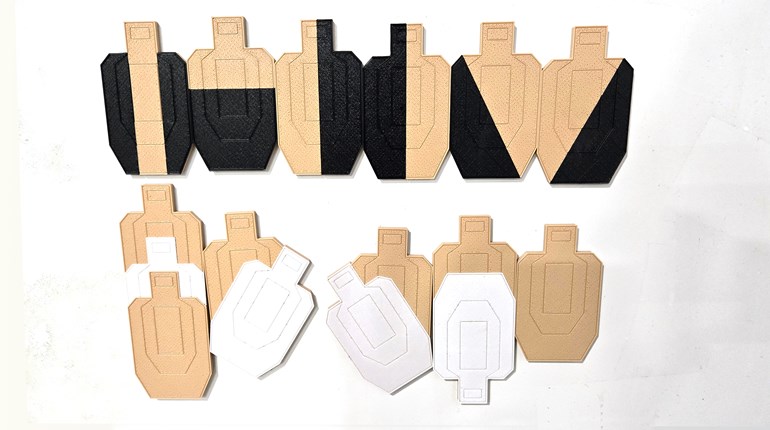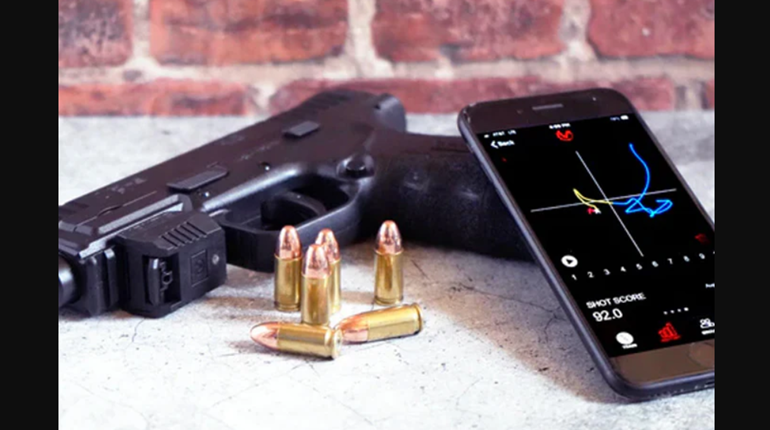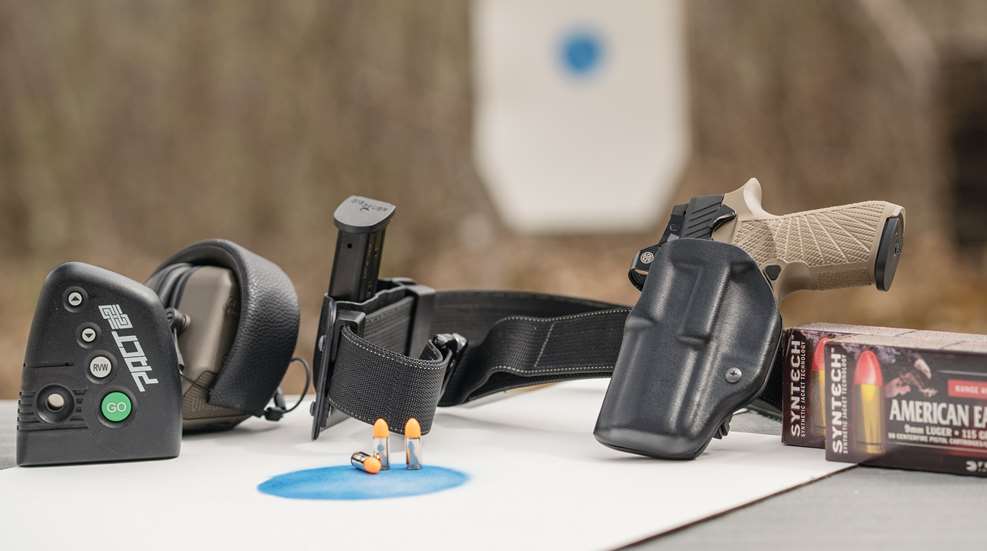
Training someone to shoot a defensive handgun is mostly a standardized process. Firearm safety is followed by firearm function, which is then followed by an introduction to the basics of marksmanship. Past that, focus falls on handgun manipulation, presentation and various methods of target engagement. The process requires lots of shooting and we’ve been doing this so long—Gunsite Academy has offered the same entry-level pistol class for 45 years—we take for granted that this is the way.
I’ve trained lots of folks following this road map, but with all the new defensive-handgun owners—many of whom cannot afford Gunsite or even less expensive local training—I wondered if the old way was, the only way. I wondered, given the current ammunition shortage, how I might now train myself. Of course, it would be impossible for me to train myself since I already know how to shoot. Right? Maybe not.
What if I attempted to learn the defensive handgun with my left hand? I’m right-handed and have done limited shooting with my support (left) hand. I’m not very good at it; heck, I can hardly pick my nose with my left hand. So, with a good understanding of defensive-handgun training, if I attempted to train myself to shoot with my left hand—like it was my primary hand—I might learn some things to help new shooters and maybe even instructors.
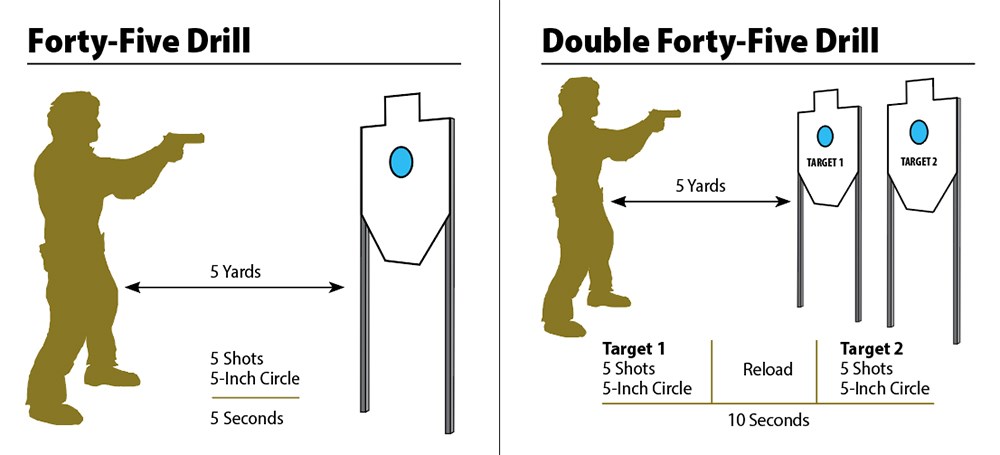
To begin, I would need a goal. I’ve written about the Forty-Five Drill many times because I think it is a great measure of defensive-handgun skill. It requires you to draw and put five rounds inside a five-inch circle, at five yards, in less than five seconds. My first goal was to be able to perform the Forty-Five Drill to standard. My second was to be able to do this twice on two separate targets, with a reload after the fifth shot, in less than 10 seconds. Though this may sound easy, most who carry a defensive handgun cannot perform either drill to standard on demand.
Initially, I planned to conduct these drills with my left hand to establish a baseline as my training advanced. I rigged up and tried some left-hand presentations, but discovered I was not safe enough to attempt this with a loaded handgun. That left dry practice as my only option. So, I designed a dry-practice routine that started with 50 presentations from the holster with a trigger press at the end. This took about 15 minutes, and I was bad at everything.
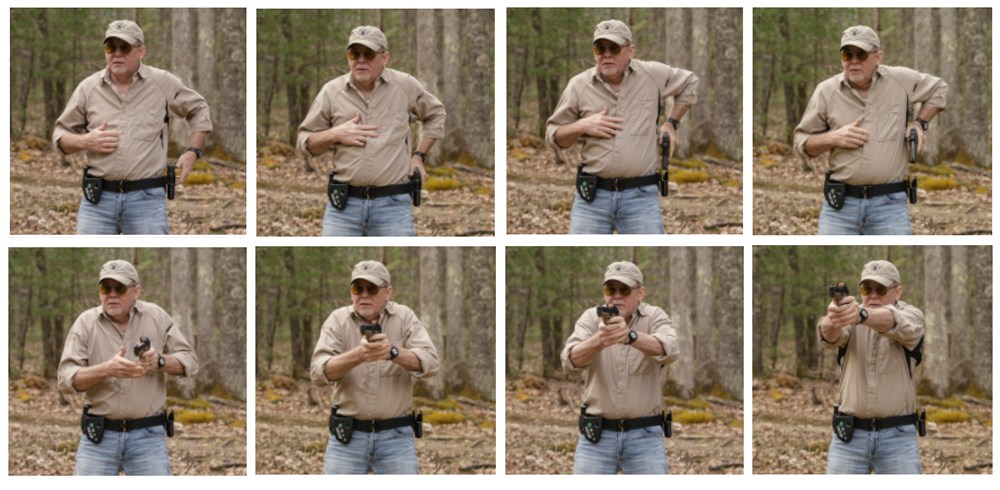
For dry practice, focus on the complete draw stroke, perfecting each element such as getting a shooting grip in the holster, applying the support hand correctly, disengaging the safety and bringing the gun up to your eyes as it’s extended toward the target.
I struggled to get a shooting grip while the gun was in the holster. Forgot to disengage the safety during presentation. Didn’t place my support (right) hand properly or deliver correct grip pressure. And, I found it difficult to acquire the sights quickly. Weirdly, it was nearly impossible for me to engage the safety with my left thumb before holstering; it just didn’t want to work that way. I also found my wedding ring painfully pinched my finger when I was gripping the handgun.

So, I re-evaluated. My new—first—goal was to dry practice until I felt safe enough to work with a loaded gun. After the second session, I also noticed my follow-through was terrible and I was dropping my head to the gun as opposed to raising the gun to my eyes. My draw stroke was improving, but I was still struggling with the safety and finding the sights.
On day three I was seeing improvement. I took day four and five off and on day six resumed. The break seemed to help; my draw stroke, safety manipulation and support-hand placement improved. So, I added speed loading to my dry-practice routine. With the handgun extended toward a target, I’d pull it back into my workspace, conduct the reload, push the gun back toward the target and press the trigger only when the sights were right. I did this slowly to commit it to memory.
After two more days I’d spent a total of two hours dry-practicing and was becoming confident. But the fun part about shooting guns is shooting guns, and I’d yet to pull a trigger on a live round. I decided on day nine I’d go live. But, immediately prior to live fire, I’d also run through my dry-practice routine, just to be sure I was safe and ready.
First, I fired a 10-shot, slow-fire group at 5 yards. It measured 1.07 inches. I then conducted 10 single shots from the holster, aiming every shot at the same spot. My average time was 2.75 seconds and the 10-shot group measured 2.44 inches. Next, I attempted the Forty-Five Drill, twice. I performed better than expected; I had no misses, but times were slow at 6.21 and 5.27 seconds. The double Forty-Five Drill with the reload humbled me; I had no misses, but both attempts took more than 14 seconds.

Reloading a handgun is a skill made for dry practice. Use dummy rounds and take your time to perfect the motions.
I was doing several things wrong. I was pressing down hard on the safety, which changed the orientation of the gun and slowed sight acquisition. My support hand was not actively involved in the grip and I was still dropping my head to the pistol. I also noticed every trigger press was a separate conscious thought. Instead of letting the sight on the target subconsciously trigger my trigger press, my eyes would see the sight and my brain would think, “OK, now it’s time to think about pressing the trigger.” My eyes were not communicating with the trigger finger on my left hand like they do with the trigger finger on my right hand. I needed more dry practice.
Embarrassingly, I had to cut my next dry-practice session short; while practicing reloads I tweaked a muscle in my back. I guess I was using a muscle that does not often get attention. This resulted in another two-day break. When I resumed, I added in a shot timer. Using delay-start and a par time of 1.5 seconds, I attempted to draw from the holster and get a good trigger press on target within that time limit. I used the same settings when practicing reloads. After three days, and three more 15-minute sessions, everything was smoother and I was almost meeting par times.
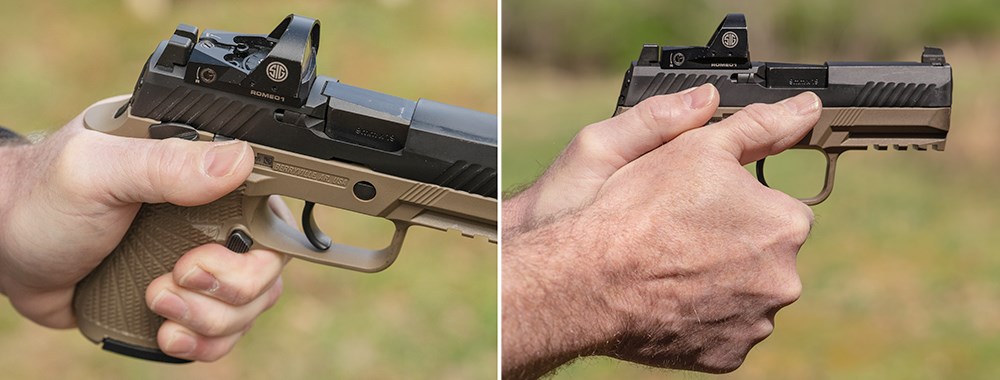
Though it may seem odd, engaging a thumb safety may be difficult for new shooters; it’s a motion our thumbs do not commonly perform. Master this during dry practice • Placement of the support hand is critical to accurate fire and recoil control. This can also be learned very well via dry practice.
On day 20 I went live again, but went through a dry-practice session just prior. The 10-shot, slow-fire group measured 1.31 inches and the 10 single shots from the holster delivered a 2.79-inch group, but in an average time of 1.95 seconds. That was a 29 percent improvement. My first run on the Forty-Five Drill produced five hits in 4.74 seconds. The second run was clean and in only 3.81 seconds. I was shocked; I’d only fired 70 rounds with my left hand. I ran the drill twice more to prove my performance was not a fluke; there were no misses, and my average was 4.24 seconds for four attempts. The real test was the double Forty-Five Drill with a reload and I managed no misses and a time of 9.56 seconds.
Much to my surprise, I’d achieved my goals with only two boxes of ammo. However, and this is most important part, I’d conducted three hours of dry practice. That works out to almost two minutes of dry practice for every round fired.
What did I learn that might help you train or maybe better teach defensive-handgun skills? Conduct at least two minutes of dry practice (triple checking to make sure your pistol is unloaded and conduct the dry practice in a room without any live ammunition present) for every round you plan to fire in an upcoming live-fire session. Start dry-practice repetitions slowly, perfecting action not speed. Focus on little things like establishing a good shooting grip in the holster, properly adding the support hand, bringing the handgun up to the eyes, manipulating the safety and making a good trigger press when the sights are on target.
As you become more proficient, try live fire to verify you’re learning. But, always conduct a dry-practice session immediately prior. Also, 50 rounds of live fire is plenty for one session; don’t bang away just to hear the gun go off. As you improve, include a shot timer in dry practice and work on speed and perfection of action. I’d also suggest some upper body stretches; you may find you’ll be using muscles you don’t normally put such stress upon.
I also learned what I already knew: dry practice sucks. I had to make myself do it. In addition to that not-so-surprising revelation, I confirmed that dry practice really works. I’ve known this, but often ignored it because, well, dry practice sucks. This exercise reinforced its critical importance in the learning process; I went from unsafe to achieving not-so-easy goals with only 100 rounds and three hours of dry practice. Dry practice is where you can learn more, easier and safer. If you’re not doing a lot of it, you’re a fool.
Safety
New shooter or old, review and adhere to the four firearm-safety rules. This is just as important with dry practice as with live fire. When conducting dry practice, always do so where you can point the firearm in a safe direction and never conduct dry practice in the presence of live ammunition. It’s also a good idea to use dummy rounds when dry practicing.
1. All guns are always loaded.
2. Never let the muzzle cover what you are not willing to destroy.
3. Keep your finger off the trigger until your sights are on the target.
4. Always be sure of your target and what is beyond it.
Guns & Gear
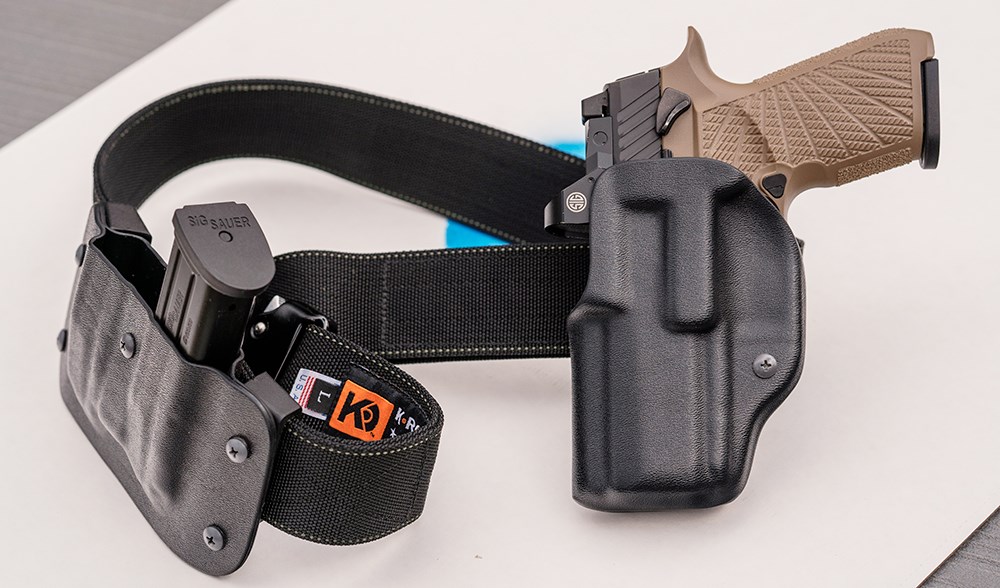
I used SIG Sauer’s ambidextrous P320 with a thumb safety because, while largely superfluous, I prefer to be able to activate a thumb safety before reholstering for added insurance against a negligent discharge. I replaced the SIG grip module with one from Wilson Combat because it fit my hand better; don’t try to learn to shoot a handgun that does not fit you. I also installed SIG Sauer’s Romeo1 reflex sight because new shooters tend to learn easier with a red dot.
It was hard to find a quality left-handed holster. Luckily, I discovered a company called K Rounds which makes excellent holsters and mag pouches for lefties and righties. Ammunition is about as hard to find, and it takes about 1,000 rounds to get through Gunsite Academy’s 250 pistol class. Initially, I figured I’d need at least half that and fortunately had a good supply of Federal 9 mm Syntech on hand. Other resources included a PACT Club Timer and a handful of highly visible dummy rounds.












